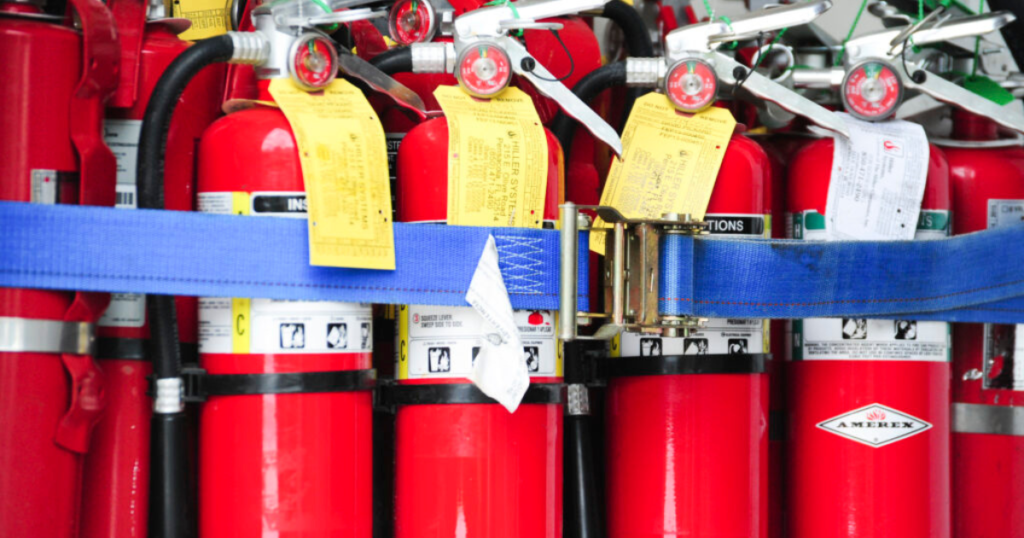When it comes to fire safety, fire extinguishers are vital tools in preventing small fires from escalating into major disasters. But not all fire extinguishers are the same, and understanding the symbols on them is crucial. Each symbol indicates the type of fire the extinguisher is designed to combat. Using the wrong extinguisher on a fire can be ineffective or even dangerous. This blog will explain the meaning behind those symbols and how to use them correctly.
The Importance Of Understanding Fire Extinguisher Symbols
Fire extinguishers are categorized based on the type of fire they are designed to tackle. Fires are divided into classes based on the material that is burning. Fire extinguisher symbols represent these classes and help users quickly identify the right tool for the job. Here’s a breakdown of the various symbols and what they mean.
Combustible Materials
Symbol: A Green Triangle with the Letter “A”
Class A extinguishers are designed to put out fires involving ordinary combustible materials like wood, paper, cloth, and some plastics. The green triangle symbol helps you quickly identify that the extinguisher is effective against fires involving these everyday items.
If you ever see a fire in a pile of papers or a wooden cabinet, this is the extinguisher you want to grab. It typically contains water or a dry chemical that works by removing the heat from the fire.
Flammable Liquids
Symbol: A Red Square with the Letter “B”
Class B extinguishers are specifically designed to fight fires caused by flammable liquids such as gasoline, oil, grease, and paint. The red square is the symbol for this class of extinguisher, and it serves as a visual cue that it is suitable for liquid fires.
Using water on a liquid fire, like a grease fire in the kitchen, can cause the flames to spread, so it’s essential to use a Class B extinguisher. These extinguishers contain chemicals that smother the fire by cutting off the oxygen supply.
Electrical Fires
Symbol: A Blue Circle with the Letter “C”
Class C extinguishers are meant for electrical fires. The blue circle symbol indicates that the extinguisher is safe to use on fires involving live electrical equipment like appliances, wiring, or circuit breakers.
Electrical fires can be particularly dangerous because using water can conduct electricity, posing a severe risk to the person trying to put out the fire. Class C extinguishers usually contain non-conductive substances such as carbon dioxide or dry chemicals, making them safe to use in these situations.
Metal Fires
Symbol: A Yellow Star with the Letter “D”
Class D extinguishers are designed to handle fires involving combustible metals like magnesium, sodium, and titanium. These types of fires are rare and usually occur in industrial settings, so you may not see Class D extinguishers in homes or offices often.
The yellow star symbol identifies this type of extinguisher. It typically contains a dry powder specifically formulated to absorb heat and control fires involving metal shavings or equipment.
Kitchen Fires (Cooking Oils and Fats)
Symbol: A Black Hexagon with the Letter “K”
Class K extinguishers are designed to tackle fires caused by cooking oils and fats, commonly found in kitchens, especially in commercial cooking environments like restaurants. The black hexagon symbol helps users quickly identify the extinguisher as suitable for kitchen fires.
Grease fires can be extremely dangerous, and using water will only make the fire worse. Class K extinguishers contain a chemical that forms a soapy foam, which cuts off the oxygen supply and cools down the fire, making it easier to extinguish.
Covering Multiple Fire Types
In many cases, you may come across fire extinguishers that are labeled for more than one class of fire. These are multi-class extinguishers, designed to handle different types of fires. The symbols on these extinguishers will combine the various class indicators.
For example, a fire extinguisher labeled ABC will have a green triangle, red square, and blue circle, indicating that it can handle fires involving ordinary combustibles, flammable liquids, and electrical equipment. Multi-class extinguishers are extremely convenient in places like offices, schools, or homes, where various types of fires might occur.
How To Use A Fire Extinguisher Safely
Understanding what the symbols mean is just the first step in fire safety. Knowing how to use a fire extinguisher properly is equally important. Follow the PASS technique to ensure you’re using the extinguisher correctly:
- Pull the pin to break the tamper seal.
- Aim the nozzle at the base of the fire.
- Squeeze the handle to release the extinguishing agent.
- Sweep the nozzle from side to side, covering the base of the fire.
Always ensure you’re using the correct extinguisher for the type of fire. Using the wrong type can worsen the fire or make it harder to control. In cases where a fire becomes too large, or if you’re unsure which extinguisher to use, it’s best to evacuate and call the fire department.
How To Read Fire Extinguisher Labels
Apart from symbols, fire extinguishers also come with labels that provide more information about their use. These labels will include:
- The Extinguisher’s Classification: Indicating the type of fire it can handle (e.g., A, B, C).
- Instructions for Use: A step-by-step guide on how to operate the extinguisher safely.
- Maintenance and Inspection: Information about when the extinguisher was last serviced and when the next inspection is due.
Fire Safety Tips
Here are some additional fire safety tips to help ensure you are prepared in case of an emergency:
- Know Your Fire Extinguishers: Keep the appropriate type of extinguisher in areas where specific fire risks are higher, such as a Class B extinguisher near the garage or kitchen and a Class C extinguisher near electrical panels.
- Inspect Extinguishers Regularly: Fire extinguishers require regular inspections to ensure they are in working condition. Check the pressure gauge, and ensure the pin is intact and the nozzle is clear.
- Have an Evacuation Plan: If a fire grows too large, your priority should always be to evacuate. Make sure everyone in the household or workplace knows the escape routes and where to gather once outside.
- Train Family or Employees: Familiarize everyone with the types of fire extinguishers and how to use them. This training can save lives and prevent panic in an emergency.
Conclusion
Understanding the symbols on a fire extinguisher is critical to fire safety. Whether it’s a small kitchen fire or a more serious electrical fire, knowing which extinguisher to use can prevent damage, injury, and even save lives. Always take the time to familiarize yourself with the different classes of fire extinguishers, and remember to regularly inspect your fire safety equipment.



